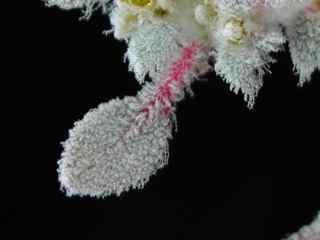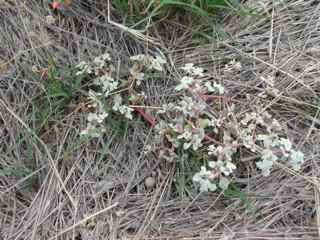|
|
 Leaves Max Licher @http://swbiodiversity.org, Usage Rights: Creative Commons Attribution-ShareAlike (CC BY-SA) |  Plant Max Licher @http://swbiodiversity.org, Usage Rights: Creative Commons Attribution-ShareAlike (CC BY-SA) | | | | |
|
Origin:
Native
Life Cycle:
Annual
General Desc:
These low-growing plants trail on the ground and form small mats or large, spreading mounds. Occasionally up to 1-1/2 feet high and 5 feet wide. Collects blowing sand.
Identification notes: Stems trailing or prostrate. Stems much branched, radiating out from the root, 4 to 24 inches long. Leaves opposite and very hairy. Yellow flowers minute and perfect in axillary clusters.
Height:
Trailing to 20 inches
Habitat Description: Primary and disturbed vegetation, riparian forests, pinyon-juniper woodlands, desert scrub, grasslands.
Plant Communities:
Desert Scrub, Interior Chaparral, Semidesert Grasslands, Pinyon Juniper Woodland, Riparian, Disturbed Areas
Elevation: Below 5500 feet
Color:
Yellowish-green
Shape:
Inconspicuous in elongated clusters
Tubular:
N
Flowering Period:
Jun - Oct
Description:
The flowers are in clusters at the leaf axils. Individual flowers are 1/8 inch wide and have 5 pointed sepals, 5 yellow-tipped stamens opposite the sepals and no petals.
Leaf Color:
Grayish-green
Leaf Type:
Simple
Leaf Shape:
Round or oval
Leaf Margin:
Smooth
Leaf Attachment:
Opposite
Leaves Clasp:
N
Hairs:
Leaves and stems
Spines:
N
Leaf Description:
The leaves are oval to heart-shaped, and densely covered in fuzzy, grayish-white hair. They are 2 inches long, including the stem, and 1 inch wide. The stems are reddish and flocked with fine, white hairs.
Fruit Color: Brown
Fruit Type: Berry-like
Seed Notes: Seed obovoid (egg-shaped, with the broad end at the top).
|
|